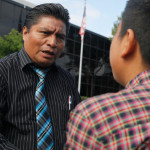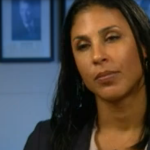Wondering About Election Laws? State Courts Site Has You Covered
WaPo Reporting On California Charter School Litigation, Issues
Study: Miami Immigration Court Is Most Lenient In Nation
The clearinghouse that tracks immigration court backlog says that some places are better than others for immigrations hoping remain in the United States. The Miami Herald reports that’s “… because judges at the Miami immigration court are deemed among the most lenient toward immigrants in the country… the report from the Transactional Records Access Clearinghouse at Syracuse University says that the Miami immigration court is in the top five immigration courts in the country whose judges are more likely to allow immigrants to stay in the country despite deportation orders sought by government trial attorneys representing the Department of Homeland Security.
According to the TRAC study, the Phoenix immigration court ranks No. 1 with “the highest proportion of individuals who were allowed to stay.” In second place was the New York immigration court, followed by Denver in third, San Antonio in fourth and then Miami in fifth, according to the study.
See the TRAC research here.
Read the newspaper’s story here: How lenient are Miami immigration judges? A study ranks the court
Here’s Summary Judgment
The National and California Courts Monitor websites are taking a summer break. We will resume daily postings on the Tuesday after Labor Day.
Private-Prison Phase-Out Will Not Apply To Immigration Jails
Shifting Immigration Sands Catches NC Teen in Kafka-esque Purgatory
For one North Carolina teen, seeing his mom again meant a difficult, six-month journey through ICE, the courts and the ever shifting immigration waters. Having fled two powerful Honduran gangs – Mara Salvatrucha (MS-13) and the 18th Street Gang – seeking to add him to their ranks, Wildon Acosta became the face of the immigration crisis for the small Durham community who rallied to support his cause.

ABC News Reports (8/16/16): Masked members of the 18th Street gang give a press conference inside the San Pedro Sula prison in Honduras, May 28, 2013.
Part of the ongoing Border Kids crisis, Acosta feared the consequences of not joining one of the two gangs. ABC News recently reported, “Those two gangs are major contributors to the violence that has made Honduras the country with the highest homicide rate in the world according to the World Bank, forcing thousands to flee their homes. The government of Honduras, according to the United Nations’ refugee agency, estimates that 174,000 people were internally displaced within the country between 2004 and 2014 because of violence and insecurity.”
When federal agents arrested him on his way to school, the story continued, Acosta had gone from speaking only Spanish to earning a B average in English-only courses. He was even held a part-time job.
Acosta is hardly the only minor fleeing the violence, either, to build a new life here in the U.S. U.S. Customs and Border Protection reports that more than 63,000 unaccompanied minors were apprehended while attempting to cross the border between October 2013 and September 2014 as the gang violence was reaching a crescendo in Central America.
The issue of overhauling the immigration system has been on the front burner since George W. Bush was president. A former Governor of a border state, President Bush attempted to overhaul the system under his tenure, but was blocked by his own party. Subsequent attempts have come close, but real reform has failed each time.
In 2014, President Barack Obama announced he was using his executive order power to bring about sweeping immigration changes. During his tenure, he has stepped up deportations, putting Border Kids at the front of the line, while also attempting to protect so-called DREAMERs. His executive orders have been stayed by the courts as states challenged his authority to implement immigration changes by executive order.
This policy uncertainty has led to myriad stories of young people caught in a shifting web of changing rules, leading to a legal purgatory that Kafka would find surreal. Were it not for the community pressuring their local member of Congress to act on his behalf, Acosta would have been deported already. With $10,000 in bail money raised in two days, he is grateful to back in his community with his family, but his future remains uncertain as he works to file a petition for asylum. The support from his community undoubtedly means that he will have legal representation to aid him in making his case to become a legal, permanent resident of the U.S.
For minors and youth with legal representation, their chances of being granted asylum are significantly better. But, as we reported back in May, Sen. Patrick Leahy said, “In immigration court, in case after case, a trained federal prosecutor represents the interests of the government while too many children facing deportation are forced to proceed before a judge without a lawyer.”
For more on the Acosta case, be sure to check out the in-depth ABC News report. You can follow along with our two-year project tracking the Border Kids crisis here.
CA Court Interpreter Funding Boost Key to Access to Justice
In states like California where roughly 44 percent of residents speak a language other than English, court interpreters are a key component to reasonably equitable justice. Just last week, we noted the backlog of California immigration cases had trumped 500,000 making court interpreters a sought after commodity.

The LA Times Reports (8/9/16): Aldo Waykam, a Mayan language interpreter, meets recently with Vinicio Nicolas, 15, outside the federal immigration court in Anaheim before Vinicio’s asylum hearing. Vinicio speaks Kanjobal, the language used in his village in the highlands of Guatemala. (Mark Boster / Los Angeles Times)
Earlier this month, the LA Times reported extensively on the challenge of Border Kids whose native language is Mayan. Many of these kids are coming in from countries such as Guatemala to escape gang violence epidemic with the drug cartels.
They report, “Spoken by almost 80,000 people in mostly rural municipalities in Huehuetenango, Guatemala, Kanjobal is common in places like Santa Eulalia… but rare everywhere else.”
As with other court funding issues; however, funding has been short. The shortages have real consequences, according to the Times Report, “The shortage of interpreters is leading to a host of issues. Often, judges delay immigration hearings until one is found. At times, asylum seekers are deported even if they have a strong case because a qualified interpreter cannot be found in time. And unlike in immigration court, interpreters aren’t provided for free during asylum hearings.”
Gov. Jerry Brown just signed into law the California budget which includes nearly a 10 percent increase in funds for court interpreters, Slator.com reports, bringing the total over $103 million. This is a major development considering the Justice Index placed California in 30th place out of 52 for language access in its 2016 report.
The money isn’t going into a vacuum either, it appears. The reporter notes, “The numbers are huge. A 2015 report by the Judicial Council of California showed that court interpreters in the state provided a total of 254,000 service days from 2012–13.”
As other states struggle with the Border Kids crisis, court interpreter funding will likely become an ever present issue demanding more attention.
Advocate Outlines Woes As Immigration Court Backlog Moves Past 500,000
In an opinion piece in The Hill newspaper in Washington D.C., a San Antonio immigration advocate outlines a recent milestone in the immigration court backlog: “In numbers just released, the backlog in immigration courts has now risen above half a million cases (500,051). Immigrants wait an average of 672 days for resolution of their cases, and for some cases the wait can reach up to six years. The highest number of pending cases are in California (93,466 cases), Texas (87,088 cases), and New York (86,834 cases).”
Sara Ramey says that “… in Texas, where my NGO RAICES serves the immigrant community, the average wait for resolution of a case is 712 days. The San Antonio court is setting hundreds, if not thousands, of cases for Nov. 29, 2019 as a place holder until the court can find a date, likely on an even later day. And this is just to start proceedings, not to determine the merits of the case.
Ramey does a good job outlining the problems when cases go that long and makes an appeal for both political parties to step up on the issue. See her argument here: http://thehill.com/blogs/congress-blog/judicial/289875-immigration-court-delays-make-a-mockery-of-us-justice



